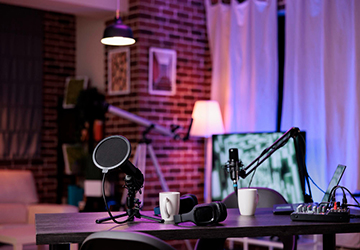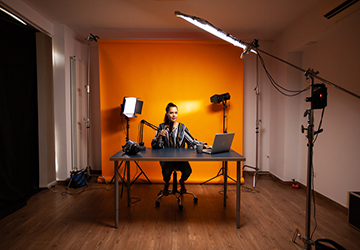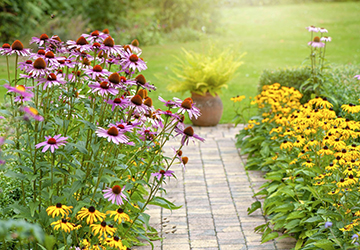Hey there, fellow content creator. Are you looking to up your game and start creating content from your comfort zone? Setting up a dedicated space for content creation is a must. Whether recording a podcast, filming YouTube videos, or working on your next hit song, having a well-designed home studio can make all the difference.
This article will walk you through setting up a home studio tailored to your needs and budget.
Top Ways to Easily Set Up a Home Studio for Content Creation
If you are a content creator and setting up a home studio, these tips are for you!

1.Choose A Suitable Location For Your Studio
For a home studio, you'll want to pick a spot that suits your needs. Some options:
· If you have an extra room, it's ideal for a studio. Make sure it's quiet and has enough space for your equipment.
· If space is limited, a corner of your living room can work. Try to isolate the area as much as possible for the best audio.
· Using your bedroom as a studio is convenient but may be distracting. Only do this if you have no other options, and be very diligent about setting boundaries.
Wherever you choose, look for an area that:
· A quiet space will give you the best results.
· Natural light is best, but if needed, supplement with soft box lights.
· Ensure you can control the thermostat for the ideal temperature to avoid overheating your equipment.
· Don't crowd your space - leave room for cameras, microphones, computers, and backdrops.
· Use doors or partitions to block out the rest of the home if possible. This helps with audio and video quality as well as privacy.
2.Get The Right Equipment For Your Content Type
To create content at home, you'll need the right equipment for what you want to produce.
Camera and Microphone
For video or live streaming, invest in a high-quality camera and mic. You don't need the latest model, but decent HD video and clear audio are must-haves. Look for a camera with autofocus, zoom, and image stabilization. For audio, a condenser mic is versatile and affordable.
Computer
A fast computer with plenty of storage is essential for editing and uploading your content. A modern Windows or Mac laptop will work great for most content creation. You may want a more powerful desktop if you're editing 4K video or using graphics-intensive software.
Lighting
Proper lighting brings a professional quality to your videos. You'll want a basic three-point lighting kit with a key light, fill light, and backlight. LED panels are inexpensive, long-lasting, and easy to set up.
Optional Gear
Depending on your content, you may also want accessories like a teleprompter, capture card, MIDI keyboard, or drawing tablet. Don't feel pressured to buy expensive gear right away. Start with the basics and add on as your needs and skills grow.
3.Set Up Your Equipment And Test It
To set up your home studio, you'll need to arrange your equipment optimally and test everything to ensure it's working correctly before you start recording.
Place your microphone, camera, and lighting in a triangle formation for the best capture of sound and visuals. The microphone should be closest to you, the subject, with the camera and lighting on either side, angled toward you. Use a microphone stand or boom arm to position the mic just out of the frame but close enough to pick up clear audio.
Place your camera on a tripod at eye level for the most flattering angle for video. Ensure all cords, cables, and wires are securely plugged in and labeled to avoid confusion. Bundle and tie excess cord lengths to keep your space clutter-free.
Consider using sound-dampening materials like foam pads or blankets to improve your audio quality by reducing echo and ambient noise.
Test your Equipment
Do a test run of your equipment to check that your microphone, camera, and lighting are working correctly and that all areas of your space are captured as intended before starting your recording. Play back your test footage, listen closely for any buzzing, humming, or static in the audio, and make any final adjustments needed to set up your optimal home studio. Your space is now ready to produce high-quality content!

4.Decorate Your Background And Add Some Personality
Decorating your background and adding some personality to your home studio space will make your content more engaging and help build your brand.
Props And Decor
Use props, posters, plants, or furniture to add visual interest to your background. Things like string lights, candles, books, artwork, or indoor plants help create a warm and inviting space. Keep your decor minimal and avoid anything too distracting.
Changeable Backgrounds
You can also use a collapsible green screen if you want the flexibility to change your background for different videos or segments. You can digitally change your location to anything with some essential video editing software. Different virtual environments make it easy to keep things fresh and match your content or topic.
Cohesive Style
Whatever background or props you choose, aim for a cohesive style that matches your content and personal brand. If you focus on productivity and organization, a minimal set with clean lines may suit you well. If you have an edgy or artistic brand, use mood lighting or hang up some original art. Your home studio should authentically reflect you and your creative work.
5.Start Creating And Have Fun!
Once your home studio is set up, it's time to initiate creating and sharing your content!
· For editing, Use free or low-cost software like Audacity (audio) or Adobe Premiere Pro (video).
· Keep content authentic and value-focused; discuss topics you genuinely care about.
· Have fun; enthusiasm shows, and perfection isn't necessary, especially at the start.
· Share videos on YouTube, TikTok, and Twitch; optimize titles, tags, and descriptions.
· Engage with viewers in comments; share snippets on Instagram, Twitter, and Facebook.
· Collaborate with other creators to expand your audience.
· Stay consistent with a regular posting schedule to build anticipation and loyalty.
Wrap-Up!
Whether you want to start a podcast, create YouTube videos, or record an album, following these tips will help you build a functional and affordable space to make it happen. Get the right equipment, set up proper soundproofing and lighting, choose an area of your home that will work well, and start creating. You'll be up and running in no time.
The possibilities are endless once you have your home studio - so get out there and start creating the content you've always dreamed of! The only thing left to do now is dive in and get started. You've got this!


